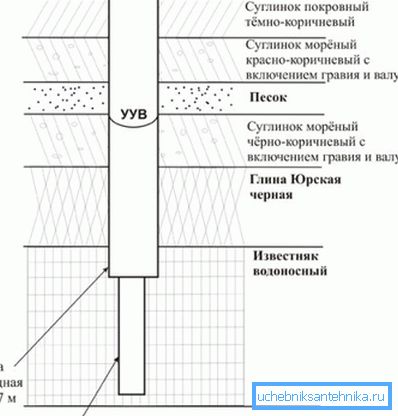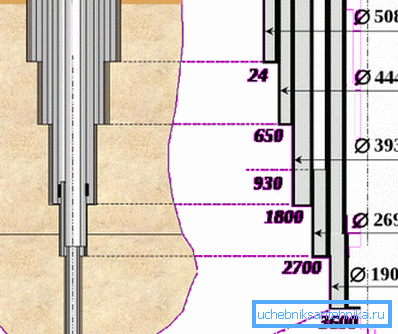What is a well on limestone
There are two main types of wells for a water source at a country site - “on sand” and “on limestone”, which is also called artesian.
It is about her that will be discussed in the article below, where you will learn about: where her name comes from, how it is drilled, how it is better to equip it, as well as its pros and cons.

General information
For the first time, water from deep-lying aquifers began to be extracted in the 12th century in the French province of Artois (in Latin Artesium), whence the name “artesian” came from. In official terms, water intake is carried out in this way from pre-anthropogenic sediments.
At the same time, it enters the surface under considerable pressure. For example, when opening such basins, many-meter fountains are very often formed or self-pouring of water to the surface occurs.
Due to the significant depth of the aquifer and its placement in geological structures, it is protected from contamination from the surface. But the chemical composition of water may be different.

When the fluid passes through layers containing iron impurities, it begins to saturate with iron, if through limestone rocks or dolomites, then lime water will also be present in the water from the well plus magnesium carbonates, which add rigidity to it. It may contain fluorine, manganese and other substances. Before purifying artesian water, they usually carry out its chemical analysis.
Currently, many owners of private homes want to have their own artesian water intake on the site. This water source has a high flow rate and can satisfy both drinking and household needs of several cottages at the same time for half a century or more.
The depth of the artesian well depends on the location of the limestone horizon and can be 20-250 m. The deeper the aquifer, the higher the level of water salinity.
Benefits:
- high capacity of water intake (5-50 m3/hour);
- constant water level;
- a certain depth of the source;
- stable aquifer;
- durability;
- practically not silted.

Disadvantages:
- the high cost of drilling, when compared with a sandy hole;
- a high level of water salinity, often requires cleaning;
- Registration of coordination and permitting documentation (license) is required.
Device and design
The choice of the method of water intake is influenced by some factors:
- geological conditions affect limestone drilling;
- required performance, depending on the technical characteristics of the pump and the diameter of the casing;
- casing parameters;
- type of pumping equipment, for example, for water intake capacity up to 5 m3/ hour you can use pumps O 100 mm.
- Classic artesian well. It is used when the aquifer is able to provide good pressure, there are no sand lenses and clay interlayers. The casing string reaches the upper horizon of the aquifer, then an open hole is placed in the limestone, whose diameter is less than the diameter of the pipes. Through this hole, water enters the water intake.
Tip: install the deep well pump at a distance of 10 m from the water mirror.

- Double cased - such a device of a well on limestone is used in the case when there is insufficient pressure in the aquifer, and in the upper layer there are sand lenses and clay. The first casing is made to the limestone boundary, then a second casing is produced using a smaller pipe diameter. They are located directly in the limestone layer, up to the upper horizon of the aquifer. There are options when the second casing is brought to the end of the water intake and perforations are made to allow water to enter the barrel.
Tip: install the pump in the lower casing.

- Well with conductor - use this option when there is no possibility to drill the upper horizons, but the water has sufficient pressure, and there is no sand lenses and clay layers in the limestone. Such drilling of limestone differs from the usual version only in the presence of the conductor. They are called a special pipe of larger diameter than the casing. Install the jig in the upper layers. This well design involves the transition to casing having a smaller diameter.

This option is used in the case when there are boulders and loose sand in the upper levels of the soil. The main casing is brought to the problem layer, and through a boulder and sand pass pipes of smaller diameter, to the upper level of limestone.
Tip: Install the pump on a smaller diameter casing.
How to choose a place to drill
When choosing a place for placing water intake, please note that it should be placed as much as possible from the point of entry. The farther the source, the longer the pipeline, and the price of the device is more expensive. The maximum depth of the source, which you can reach with your own hands - 20 m.
When the aquifer limestone is located below, entrust the job to professional drillers. Below we will learn how all this is done, but first prepare the site, align it and fence it.
Drilling stages
- rock is destroyed in various ways, including mechanical, electrical, thermal, explosive;
- raise the sludge up, for which use mechanical, pneumatic or combined method;
- make a casing of water intake;
- install pumping equipment.
Well Construction:
- make the installation of the caisson (from reinforced concrete, steel or plastic), the installation instructions of which are on our website;
- mounted submersible pump;
- install electrical equipment;
- install an automatic unit and hydroaccumulator;
- lay the pipeline to the house.
The appearance of the well will depend on your imagination. For example, you can decorate it under a barrel, gazebo or well.
Conclusion
With the help of an artesian well, water is delivered to the surface from calcareous layers located at great depth. Independently to drill such a well is very, very problematic. In the presented video in this article you will find additional information on this topic.